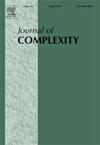Computing approximate roots of monotone functions
IF 1.8
2区 数学
Q1 MATHEMATICS
引用次数: 0
Abstract
We are given a value-oracle for a d-dimensional function f that satisfies the conditions of Miranda's theorem, and therefore has a root. Our goal is to compute an approximate root using a number of evaluations that is polynomial in the number of accuracy digits. For this is always possible using the bisection method, but for this is impossible in general.
We show that, if and f satisfies a single monotonicity condition, then the number of required evaluations is polynomial in the accuracy. The same holds if and f satisfies some particular monotonicity conditions. We show that, if and f satisfies a single monotonicity condition, then the number of required evaluations is polynomial in the accuracy. The same holds if and f satisfies some particular monotonicity conditions. In contrast, if even two of these monotonicity conditions are missing, then the required number of evaluations might be exponential.
As an example application, we show that approximate roots of monotone functions can be used for approximate envy-free cake-cutting.
计算单调函数的近似根
我们给出一个d维函数f的值神谕,它满足米兰达定理的条件,因此有一个根。我们的目标是使用若干次求值来计算一个近似的根,这些求值是精度位数的多项式。当d=1时,这总是可以用等分法,但当d≥2时,这通常是不可能的。我们证明,如果d=2且f满足单一单调性条件,则所需求值的次数在精度上是多项式。如果d≥3且f满足某些特定的d2 - d单调性条件,同样成立。我们证明,如果d=2且f满足单一单调性条件,则所需求值的次数在精度上是多项式。如果d≥3且f满足某些特定的d2 - d单调性条件,同样成立。相反,如果缺少这些单调性条件中的两个,则所需的计算次数可能是指数级的。作为一个应用实例,我们证明了单调函数的近似根可以用于近似无嫉妒切饼。
本文章由计算机程序翻译,如有差异,请以英文原文为准。
求助全文
约1分钟内获得全文
求助全文
来源期刊

Journal of Complexity
工程技术-计算机:理论方法
CiteScore
3.10
自引率
17.60%
发文量
57
审稿时长
>12 weeks
期刊介绍:
The multidisciplinary Journal of Complexity publishes original research papers that contain substantial mathematical results on complexity as broadly conceived. Outstanding review papers will also be published. In the area of computational complexity, the focus is on complexity over the reals, with the emphasis on lower bounds and optimal algorithms. The Journal of Complexity also publishes articles that provide major new algorithms or make important progress on upper bounds. Other models of computation, such as the Turing machine model, are also of interest. Computational complexity results in a wide variety of areas are solicited.
Areas Include:
• Approximation theory
• Biomedical computing
• Compressed computing and sensing
• Computational finance
• Computational number theory
• Computational stochastics
• Control theory
• Cryptography
• Design of experiments
• Differential equations
• Discrete problems
• Distributed and parallel computation
• High and infinite-dimensional problems
• Information-based complexity
• Inverse and ill-posed problems
• Machine learning
• Markov chain Monte Carlo
• Monte Carlo and quasi-Monte Carlo
• Multivariate integration and approximation
• Noisy data
• Nonlinear and algebraic equations
• Numerical analysis
• Operator equations
• Optimization
• Quantum computing
• Scientific computation
• Tractability of multivariate problems
• Vision and image understanding.
 求助内容:
求助内容: 应助结果提醒方式:
应助结果提醒方式:


